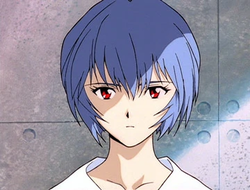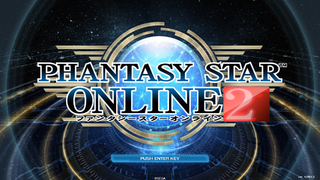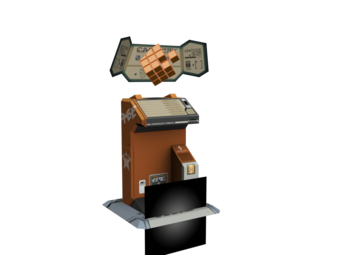Phantasy Star Online 2
| Phantasy Star Online 2 |
|---|
|
Developer: Sega
|
Phantasy Star Online 2 (not to be confused with Phantasy Star Online Episode II) is the much-anticipated sequel to the original Phantasy Star Online and a pseudo-sequel to Phantasy Star Universe, sharing numerous core mechanics with the latter and its derivatives.
While English versions of the game were available to play in the Southeast Asia region, these servers were behind in updates and region-locked, and ultimately closed in 2017. Sega infamously advertised a Western release which was not heard from for 7 years until a North American release was announced again at E3 2019 along with an Xbox One port.
Contents
Sub-Page
| Prerelease Info |
Unused Areas
Testing Area
While there's no way to access this area normally, this is a rough approximation of how it should be, minus the objects from the original room it was force-loaded over. As one can see, there's a number of spheres with different shaders which interestingly have their own animations. There's a generic blue sky texture that goes with it, but unfortunately it has no model to go over. There's also the usual test room measurements spread along the room. The door in the building area is part of the terrain geometry and doesn't seem to open, but using a model viewer reveals nothing behind it besides a continuation of the inside of the building.
Perhaps the most interesting thing is that the grassy area is taken directly from the original city area in the earliest known video of the game, shown to the right of the test area video. Unfortunately, while there are textures that correlate to other parts of that video, the actual terrain models don't seem to exist in any known public build of the game. However, the naming conventions of these textures are a little different then those of final area textures. Dark Ragne's arena texture names make it the only area in the final game to follow that convention, and so likely one of the earliest areas finished in the game.
Unused Graphics
Dewman Skin Scars
While in the concept art, there's also an in-game version of the original Dewman race scars which seem somewhat reminiscent of the dragonkin species. A female variant can be found in 314586c89058952390b615ce5865c012 while a male version can be found in cc680fca713d2eeb9eabcc8c7e6d2162. This likely would have simply replaced the dewman skin body paint used in the final game although it's unclear whether it would have originally been forced or not.
Hero Finish
Unused Hero Finish Animation
This version of Hero finish was left unused in the files in past patches. It was recreated with its assets over another animation for example's sake. The end of the modern hero finish player animation seems to use similar frames, however the effects are entirely different and much more exaggerated than in the final game with a large, far traveling blast projectile instead of a series of localized area of effect hits.
Healing animations
In the final version of the game, the players using items to heal their person specifically will drink said items. Inside each of the 4 main animation archives (human m/f, cast m/f), there are 4 unused healing animations for monomates, dimates, and trimates. One is an injection animation from the alpha test of the game. This was allegedly removed after the playerbase mentioned it making them uncomfortable to the dev team during testing. The next 3 animations are 51, 76, and 101 frame eating animations that match the speeds of the drinking mate animations in the final build. Assumedly, these were an alternative to the drinking animations which are used in the final for mates. It's worth noting there are foods to eat in the final game, but all of these have always taken effect instantaneously in public builds of the game with no animation to speak of. All animations are also in the newer version of the animation format in final.
Orange Campship Storage Bank
While there's normally a standard looking green storage device in the campship and there exists a yellow storage unit in the team room, this is a bit different. As "ob_0150_0015", it's next to the similarly orange challenge mode color variants of campship objects that are actually used. Interestingly, while objects go from 0 to 17 as of this writing for campship objects, object 16, which should be directly after this, is nonexistent in the files. Found in 7bfde8e2be57a825597c934fa09604ec.
Ultimate Lilippa Conveyor Belts
Models and textures for conveyor belts in the Ultimate variant of the Tunnels area exist in e5a880512be057ea57235c0e537f0677 and f3aa34e2800a20ea523be10d941edecc ICE archives. While the models are likely nearly the same as the originals, it's worth noting that the textures were updated to match the look of the Ultimate variant as well and appear to even be functional if used to replace the original files in the normal version of Tunnels.
Rei Ayanami Hair
| PSO2 | Evangelion |
|---|---|
 |
 |
While not strictly unused, the default hair of 'Short Bob', or 'Base Hair 23' as PSO2 Global calls it, is clearly based on Rei Ayanami's hair. While this may not be apparent with its default coloration ingame, with the diffuse texture alone it becomes a lot more obvious. While it's not 1:1, almost every major hair strand in Rei's hair is matched by the PSO2 hair and the texture's true coloring, which gets overwritten ingame, all but confirms it. Rei's hair color has varied but is sometimes depicted exactly as in the pso2 version. The model and texture were present in the first alpha version of the game and so suggest less of a failed collab and more of a purposeful, legally distinct usage.
Interestingly, many years later the game did actually collaborate with this franchise and another interpretation of the hair was modeled.
Unused Code
Excerpt from change_color.lua
Within this script, there's a failure condition for changing weapon color at the item lab. While some item lab actions can fail, this has never been one of them publicly. The action also has no cost which implies that at one point there may have been an item or currency the player must spend to attempt the action.
L5_4 = Window L5_4 = L5_4.Labo L5_4 = L5_4.ChangeColor function L5_4.FailSeAssign() local L0_7, L1_8 L0_7 = "10_interface_rabo_failed" return L0_7
title.adv.lua
Interestingly, much of this file in its current iteration, if not all of it, seems to be code for the main menu of the 'PSO2 1ST' build referenced in 'Testing Area' under Unused Areas. While the myriad changes since this build and missing graphics imply that it probably isn't possible to run, it's interesting to see it still here after more than 10 years of development.
Unused Weapons
A number of weapons in the classic PSO2 section of the game never made it into players' hands. While PSO2's Global release notably has an incredible number of these due to weapon category optimization, even in the Japanese version there are many which simply aren't used. Most of these are simply 1 or 2 recolors of an existing weapons the way the game's myriad "Lambda" and "Dio" weapons exist. However, there are also a number of NPC only variations of weapons, which while often used by the actual NPCs are typically just direct copies of what player characters have access to.
There are also a weapons seemingly made for debugging purposes in the episode 1 categories. All of them are id 999 (PSO2 classic weapon ids stay under 500 in all other cases), use the model of the first 1* weapon of the category, and have an aqua colored gradient pattern textured with hexagons on them. This is undoubtedly in reference to the the game's "Aqua" libraries used throughout the game's code, the name itself perhaps even being an internal name for PSO2. There is also a similarly appearing mag of id 999.
Unused Music
MAIN
| To do: I've found this set of files in other CPK files like Urban's music with the name 'forest' in the file name replaced with urban. It would be interesting to see what other CPK music files have this set of files, and if there is anything else different with them. |
Located in Forest's music CPK file (3be9faae726c5ea5ec14c6c7ed9326fc) is this set of 16 audio files with the title of MAIN. The file names of these audio files LD1_forest_MAIN_XXX.hca don't really give out any information about their purpose.
| Filename | Audio |
|---|---|
| LD1_forest_MAIN_001.hca | |
| LD1_forest_MAIN_002.hca | |
| LD1_forest_MAIN_003.hca | |
| LD1_forest_MAIN_004.hca | |
| LD1_forest_MAIN_005.hca | |
| LD1_forest_MAIN_006.hca | |
| LD1_forest_MAIN_007.hca | |
| LD1_forest_MAIN_008.hca | |
| LD1_forest_MAIN_009.hca | |
| LD1_forest_MAIN_010.hca | |
| LD1_forest_MAIN_011.hca | |
| LD1_forest_MAIN_012.hca | |
| LD1_forest_MAIN_013.hca | |
| LD1_forest_MAIN_014.hca | |
| LD1_forest_MAIN_015.hca | |
| LD1_forest_MAIN_016.hca |
CLEAR
Located in the same CPK files which have the MAIN audio files, these CLEAR files were used in the first alpha of the game, but were replaced with the "Road to Next Frontiers" music track (the files of which are named in the format of CLEAR_location_xx_xx.hca) when the beta version was released.
This music would later be extended to be used for the Parallel Area music.
| Filename | Audio |
|---|---|
| CLEAR_forest_01_001.hca | |
| CLEAR_forest_01_002.hca |
This music can be heard playing in this alpha gamplay video.
Urban's Unused Normal to Battle Transitions
Urban's CPK file contains these two files which are labelled as NtoB. Files with this label are used in other CPK files for the transition between the calm and battle versions of a music track, but in this case, the audio suggests that the music would transition into the Parallel Area music. This could have been used as a transition between Urban's and the unused CLEAR music mentioned above.
| Filename | Audio |
|---|---|
| NtoB_SLOW.hca | |
| NtoB_FAST.hca |
Dark To Light Variants
The CPK containing the final boss theme Dark To Light has several variants that use corrupted vocals rather than the actual lyrics. It is unknown what purpose these tracks have and they are confirmed to not be used for the solo Ultimate quest against this boss at Depth 100.
| Filename | Audio |
|---|---|
| pd2_FH_xxx_T226_B12.hca |
JP PS4 2016 disc NA remnants
While multiple NA remnants exist, this is the one voiced NA sample from the game in this version. While distorted, this is clearly Quna singing her track in English. This was many years before the official English release.
Localization Changes
| To do: According to the YouTube channel The Audio Visiphone PSO2, the dialogue for the removed Bathhouse scene was fully dubbed, and the voiceline files remain in the game. Find and extract them? |
While an official statement has never been given from Sega on the matter, there are a number of changes and omissions from the Japanese release. It is theorized that part of this was a condition from Microsoft or for the game to retain its initial T rating, which became M in later expansions. Notably, the Smart Inner (an innerwear which was essentially pasties) was removed, outfits such as the default female CAST basewear which were meant to be covered by the inner wear under them on the bust had covering added there (changes that were made to outfits in the global version were reverted with the release of New Genesis), and the bathhouse scene was removed from the Global release. Some item names were also shortened, presumably to fit the length limit required by some interfaces in the original, larger font. However, these were generally left alone later despite the game launching with an alternate, smaller font while later expansion items were brought in without this character limit.
A rather infamous change from the Japanese release was the replacing of most item descriptions in PSO2 with generic descriptions. Most items in the Japanese release had fun descriptions that said simple things about the item, whether they be something lore related or simply silly. Instead in the Global release, a furniture item might instead have a description such as 'Furnishings that can be placed in your personal quarters'. It's not entirely clear why this was done, but many suspect that with the NGS expansion being within a year of the Global release that Sega simply didn't want to waste money on translation efforts. Indeed, all items in the Global release DO have a proper, unique description in Japanese, including the ones exclusive to the Global release. Despite this, not long before the release of NGS, armor units alone were given translated descriptions.
There are also various instances of items and in one case a character being renamed to avoid potential racist controversy. An NPC named 'Diggah', which was a brown colored cast character, was renamed, potentially to avoid similarity to a variation of the N swear. In addition weapons such as the 'Illegal Negro' was changed along with the entire 'Slave' weapon series which became the 'Raven' series.
The Harkotan planet received some pretty sweeping changes to the various areas and factions as well due to the bluntness of their original names. Clearly intending to represent a yin and yang relationship and with a less strenuous cultural belief on particular colors, the warring factions of Harkotan would be literally translated as 'white people' and 'black people', hailing from a land of white and a land of black, with the player's role to end up helping the white people faction fend off the attacking black people faction. While the factions are made up primiarily of Japanese oni and various youkai type monsters, it's pretty apparent to a Western audience how the naming might cause controversy here. Instead, the 'white people' became the Daybreakers while the 'black people' became the Nightfallers, a clever handling of the names that gets across the original intent while avoiding problematic implications.
Perhaps one of the more amusing changes in Global was how the "The Call of the Void Trigger" originally came into the game as "The Call of the Void Tigger", unintentionally implying a fight against a cosmic-horrorfied Winnie the Pooh character. This was fixed in a later patch.
The Phantasy Star series
| |
|---|---|
| Master System | Phantasy Star |
| Genesis | Phantasy Star II (Localization Prototype) • Phantasy Star III: Generations of Doom • Phantasy Star IV: The End of the Millennium (Localization Prototypes) |
| PlayStation 2 | Sega Ages 2500 Series Vol. 17: Phantasy Star generation:2 • Sega Ages 2500 Series Vol. 32: Phantasy Star Complete Collection |
| Phantasy Star Online | |
| Dreamcast | Phantasy Star Online |
| GameCube | Phantasy Star Online Episode I&II • Phantasy Star Online Episode III: C.A.R.D. Revolution (Prototype) |
| PlayStation 2 | Phantasy Star Universe |
| Nintendo DS | Phantasy Star 0 |
| PlayStation Portable | Phantasy Star Portable • Phantasy Star Portable 2 |
| PlayStation Vita | Phantasy Star Nova |
| Xbox 360 | Phantasy Star Universe |
| Windows | Phantasy Star Online • Phantasy Star Universe • Phantasy Star Online 2 • Phantasy Star Online 2: New Genesis |
- Pages missing developer references
- Games developed by Sega
- Pages missing publisher references
- Games published by Sega
- Windows games
- PlayStation Vita games
- PlayStation 4 games
- Xbox One games
- Pages missing date references
- Games released in 2012
- Games released in July
- Games released on July 4
- Games with unused animations
- Games with unused areas
- Games with unused code
- Games with hidden development-related text
- Games with unused graphics
- Games with unused models
- Games with unused items
- Games with unused abilities
- Games with unused music
- Games with unused text
- Games with regional differences
- To do
- Phantasy Star series
Cleanup > Pages missing date references
Cleanup > Pages missing developer references
Cleanup > Pages missing publisher references
Cleanup > To do
Games > Games by content > Games with hidden development-related text
Games > Games by content > Games with regional differences
Games > Games by content > Games with unused abilities
Games > Games by content > Games with unused animations
Games > Games by content > Games with unused areas
Games > Games by content > Games with unused code
Games > Games by content > Games with unused graphics
Games > Games by content > Games with unused items
Games > Games by content > Games with unused models
Games > Games by content > Games with unused music
Games > Games by content > Games with unused text
Games > Games by developer > Games developed by Sega
Games > Games by platform > PlayStation 4 games
Games > Games by platform > PlayStation Vita games
Games > Games by platform > Windows games
Games > Games by platform > Xbox One games
Games > Games by publisher > Games published by Sega
Games > Games by release date > Games released in 2012
Games > Games by release date > Games released in July
Games > Games by release date > Games released in July > Games released on July 4
Games > Games by series > Phantasy Star series







